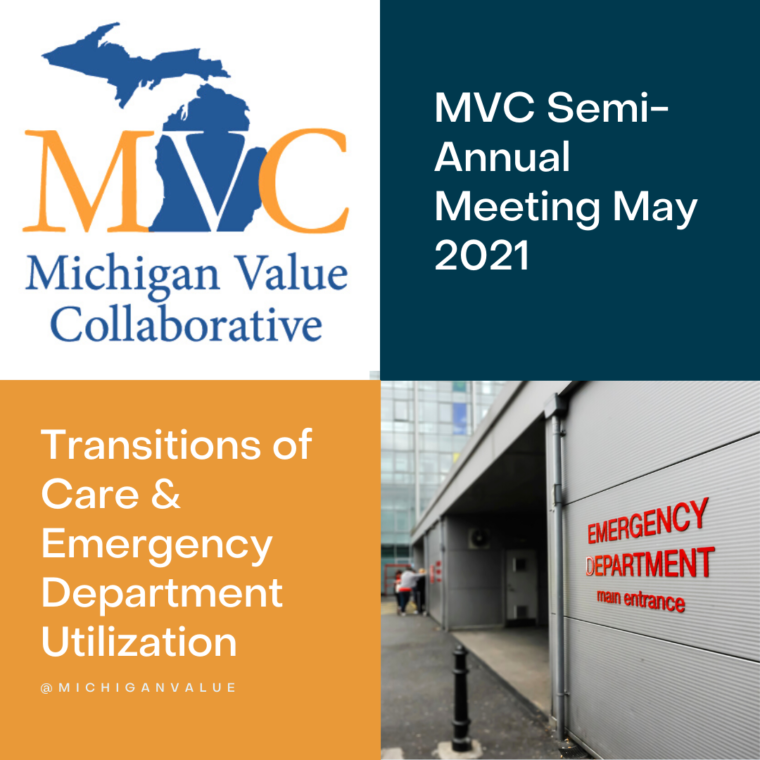The Michigan Value Collaborative (MVC) held its first virtual semi-annual meeting of 2021 on Friday, May 7th. A total of 221 leaders from a variety of healthcare disciplines attended Friday’s virtual meeting, representing 74 different hospitals and 30 physician organizations (POs) from across the State of Michigan. These participants came together to hear about the planned adjustments to the MVC Component of the BCBSM P4P Program for Program Years (PY) 2022/23 and to discuss variations in transitions of care and ED utilization practices across Michigan.
MVC’s Director, Dr. Hari Nathan, started Friday’s meeting with an update from the MVC Coordinating Center, welcoming the eleven new hospital members who have joined the collaborative since the turn of the year and highlighting recent improvements to MVC data sources and push reporting. This included the “soft launch” of Medicaid data. MVC has now added Medicaid data to our data portfolio, meaning that MVC data sources now comprise over 80% of Michigan’s insured population. The Coordinating Center is in the final stages of validation and will have this new data source live for use by members in the coming months.
Dr. Mike Thompson, MVC’s Co-Director, then shared information on the MVC Component of the BCBSM P4P Program with attendees. An overview of PY20 was first provided, showing that participants earned an average of six points during this program year, an increase of around one point from the 2019 program year average. In an effort to continually improve the MVC Component, the Coordinating Center has introduced two methodological changes for the next two-year cycle (PY22 & PY23). Dr. Thompson walked through each of these changes, which include placing “Improvement” and “Achievement” on the same scoring scale, and introducing a new qualitative questionnaire for earning bonus points. The MVC Coordinating Center will be sharing further information on these changes and disseminating service line selection reports for the next program cycle with members in early June. Two dedicated P4P webinars will also be held around this time to assist members with selection.
Attention was then turned to looking at transition variations in Michigan hospitals, highlighting payment and ED utilization differences across MVC members, as well as the top reasons for readmission within the collaborative. To expand on this further, we were joined by guest speakers from the hospital, physician organization, and CQI setting to share their insights and learning. Dr. Robert Nolan and Michael Getty from Spectrum Health Lakeland were the first guest speakers of the day, discussing their organization’s efforts to reduce the cost of ED utilization and readmission rates. This highlighted the importance of real time data visuals, integrating documentation tools with best practices, and ensuring an effective longitudinal plan of care that is blended into natural work flows to enable physician buy-in. Dr. Nolan and Mike Getty were also able to spotlight the use of MVC data in these efforts, a custom option available to all MVC members.
Representing Professional Medical Corporation (PMC) and the Consortium of Independent Physician Associations (CIPA), Dr. Kyle Enger then shared how both entities have worked to promote appropriate emergency care in recent years. Again, this emphasized the importance of monthly data report cards to provide physicians with actionable data to guide activity, as well as the need to continue promoting urgent care as a viable alternative in certain situations. Our last guest speaker of the day was Dr. Keith Kocher, Director of the Michigan Emergency Department Improvement Collaborative (MEDIC). As well as providing a brief overview of the purpose of MEDIC and sharing some vital statistics relating to ED utilization across the US, Dr. Kocher discussed how best to approach the “ED readmission problem” and how local solutions can be used to minimize its impact.
To conclude Friday’s meeting, MVC’s Site Engagement Coordinator, Jeff Jameel, provided a synopsis of the day and highlighted key upcoming activities. The slides from Friday’s meeting are available here and a recording of the meeting can also be viewed here. If you have any questions on anything that was discussed at Friday’s semi-annual or are interested in finding out more about MVC’s offering, please reach out to the MVC Coordinating Center (michiganvaluecollaborative@gmail.com.) In the meantime, we look forward to seeing you all in-person again soon.
